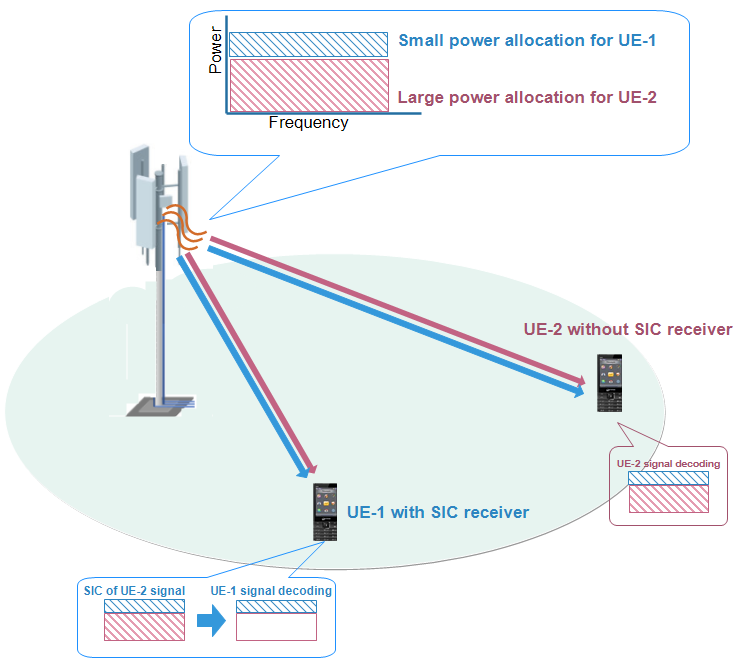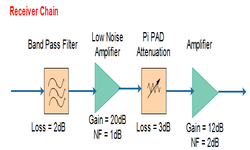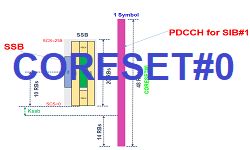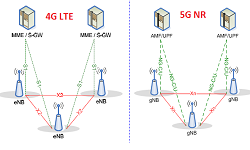Explaining NOMA basic concept, how is it different from OFDMA and applications of NOMA for 5G ?
Non-orthogonal multiple access (NOMA) has been recently recognized as a promising multiple access technique to significantly improve the spectral efficiency of mobile communication networks.
In 1G, 2G, and 3G, frequency division multiple access (FDMA), time division multiple access and code division multiple access were introduced, respectively. In Long-Term Evolution (LTE) and LTE-Advanced, orthogonal frequency division multiple access (OFDMA) and single-carrier (SC)-FDMA are adopted as an orthogonal multiple access(OMA) approach. Such an orthogonal design has the benefit that there is no mutual interference among users, and therefore good system-level performance can be achieved even with simplified receivers. However, none of these techniques can meet the high demands of future radio access systems such as 5G.
The increasing demand of mobile Internet and the Internet of Things poses challenging requirements for 5G wireless communications, such as high spectral efficiency and massive connectivity. In this article, a promising technology, non-orthogonal multiple access (NOMA), is discussed, which can address some of these challenges for 5G.
NOMA Basic Concept
Figure below illustrates downlink NOMA for the case of one BS (base station) and two UE (user equipment).
In downlink NOMA, the transmit signal from the BS and the received signal at both UE receivers is composed of a superposition of the transmit signals of both UEs.
Thus multi-user signal separation needs to be implemented at the UE side so that each UE can retrieve its signal and decode its own data. This can be achieved by non-linear receivers such as maximum likelihood detection or SIC (Successive Interference Cancellation).
For the case of SIC, the optimal order for decoding is in the order of the decreasing channel gain normalized by noise and ICI power. Based on this order, we can actually assume that any user can correctly decode the signals of other users whose decoding order comes before the corresponding user.
In a two-UE case, assuming that, UE-2 does not perform interference cancellation since it comes first in the decoding order. UE-1 first decode UE-2 signal, and subtracts its component from total received signal, and thus it gets its own signal component and decodes it, without interference from UE-2 signal.
NOMA uses the power domain to separate signals from each other. NOMA gives a new dimension in which signals can be separated and given access to a base station. This technique that has not been used within 2G, 3G or 4G before.
Comparison with OFDMA
In OFDMA, different UE signals are transmitter at different frequency resources, but in case of NOMA, different UE signals are transmitted at same frequency but at different power levels depending upon the position of UE in the cell. The performance gain of NOMA compared to that of OFDMA increases when the difference in channel gain the path loss between UEs is large. According to this simple two-UE case, NOMA provides a higher sum rate than OFDMA. In fact, the cell-center UE gains in terms of rate since this UE is bandwidth-limited and thus benefits more from being able to use double bandwidth, even if this comes at the price of much lower transmit power. Meanwhile, the cell-edge UE also gains in terms of rate since it is power-limited; its transmit power is only slightly reduced under NOMA but its transmit bandwidth can be doubled.
Applications of NOMA to other 5G scenarios
As a promising 5G technique, NOMA has been shown to be compatible with other key enabling techniques for 5G communications. For example, the heterogeneous network architecture will play an important role in 5G networks, where macro base stations and small cell base stations cooperate for spectrum sharing. The NOMA is beneficial for heterogeneous networks, as more users can be served in a small cell by exploiting the NOMA principle. At the same time, the applications of NOMA to machine-to-machine (M2M) communications, ultra-dense networks (UDN), and massive machine type communications (mMTC) are being studied, respectively, where the use of NOMA can effectively support massive connectivity and the IoT functionality of 5G.
With its distinct features, NOMA stays as the strongest candidate for the future 5G networks. There are, however, still some challenges for successful implementation of NOMA. First of all, it requires high computational power to run SIC algorithms particularly for high number of users at high data rates. Second, power allocation optimization remains as a challenging problem, particularly when the UEs are moving fast in the network. Finally, SIC receiver is sensitive to cancellation errors which can easily occur in fading channels. It can be implemented with some other diversity techniques like multiple-input-multiple-output (MIMO) or with coding schemes in order to increase the reliability and accordingly reduce the decoding errors.
The current state of the art for NOMA, however, is still far from its potential and requires further investigation.





